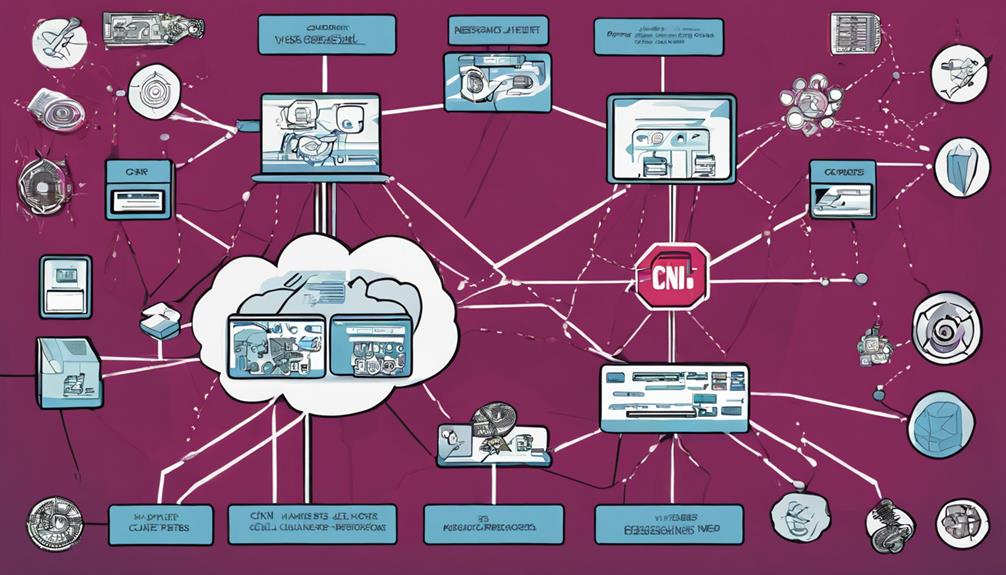When considering the most popular CNI for Kubernetes, assess factors like network compatibility, performance, and security to make an informed choice for your cluster's needs. Different CNIs offer varying features and benefits, like network model compatibility, scalability, and adherence to Kubernetes Network Policies. Calico, Cilium, Flannel, and Weave Net are popular options with distinct characteristics worth exploring. Understanding these CNIs can help you optimize network performance and security. Further insight into operational mechanics, ecosystem integration, and community support can guide your decision for seamless Kubernetes networking. Additional details will provide deeper insights into the best CNI for your setup.
Key Takeaways
- Consider network model compatibility, performance, security, scalability, and community support.
- Evaluate features such as BGP routing, eBPF filtering, encryption, and network policy enforcement.
- Assess the ease of setup, integration with Kubernetes, and support for network isolation.
- Compare Calico, Cilium, Flannel, and Weave Net for performance and scalability.
- Choose based on efficient data path, robust security, scalability, and community backing.
CNI Plugin Considerations
When evaluating CNI plugins for Kubernetes, consider their impact on network performance, scalability, and security.
CNI plugins play an important role in managing network setup, teardown, and isolation for efficient pod-to-pod communication within Kubernetes clusters. It's necessary to assess the compatibility of a CNI plugin with your network model to guarantee seamless integration. Additionally, examine the security features offered by the plugin, as security and policy enforcement capabilities can vary significantly. Some plugins support Kubernetes Network Policies, enhancing security within the cluster.
Scalability is another key consideration when selecting a CNI plugin. You want a plugin that can easily scale with your Kubernetes infrastructure as your cluster grows. Moreover, understanding how the plugin interacts with network namespaces is crucial for efficient pod networking.
Key Selection Factors

Considering various factors is important when selecting a CNI plugin for Kubernetes. To make the best choice, you should focus on:
- Network Model Compatibility: Confirm the CNI aligns with your network model to avoid compatibility issues.
- Performance Requirements: Evaluate if the CNI can meet your performance needs for efficient Kubernetes operations.
- Security Features: Look for CNIs with strong security measures to protect your Kubernetes environment.
- Scalability: Choose a CNI that can scale alongside your Kubernetes clusters to accommodate growth.
These factors are vital in determining the right CNI plugin for your Kubernetes networking requirements.
Additionally, evaluating policy enforcement, community support, and the ability to test multiple CNIs can further enhance your decision-making process.
Operational Mechanics Overview

CNI plugins within Kubernetes actively manage network setup and teardown processes, facilitating pod-to-pod communication in isolated environments. These plugins play an essential role in the operational mechanics of Kubernetes, ensuring smooth integration with the Kubernetes pod lifecycle.
They handle network configuration, work within network namespaces, and are pivotal for maintaining network model compatibility. When selecting a CNI plugin, factors like performance, security features, and scalability must be carefully considered to optimize network operations.
The operational mechanics of CNI plugins impact the overall network performance and operational complexity of Kubernetes clusters significantly. Choosing the right CNI plugin is crucial for achieving efficient network management, seamless pod communication, and overall cluster performance.
Make sure to evaluate how well a CNI plugin aligns with your network requirements to streamline network operations within your Kubernetes environment.
Role in Kubernetes Networking

CNI plugins serve as the backbone of Kubernetes networking, facilitating network abstraction and enhancing pod communication.
They're instrumental in ensuring seamless connectivity between containers, enabling efficient data exchange within the cluster.
Understanding how CNI plugins optimize network performance is key to leveraging Kubernetes networking capabilities effectively.
Network Abstraction Mechanism
Within Kubernetes networking, the Network Abstraction Mechanism stands as a central component that abstracts the complexities of networking configuration for containers. It's facilitated by CNI plugins, automating the setup and teardown of network resources to enable smooth communication between pods in a cluster.
This mechanism ensures network isolation, scalability, and security for containerized applications. CNI plugins play an essential role in handling network namespaces, pod networking, and communication between pods in Kubernetes.
Pod Communication Enhancement
Efficient pod communication plays an important role in optimizing performance and reliability within Kubernetes networking. CNI plugins such as Calico and Flannel are instrumental in enhancing pod-to-pod communication in Kubernetes clusters. These plugins facilitate network setup and maintenance, ensuring seamless connectivity between pods.
By enabling pod communication across nodes, CNI plugins guarantee efficient data transfer, network isolation, and secure routing. Maintaining efficient pod communication is essential for sustaining cluster performance and application reliability. CNI plugins play a key role in ensuring that pod communication within Kubernetes environments is secure, isolated, and conducive to efficient data exchange.
When choosing a CNI for Kubernetes, considering its impact on pod communication enhancement is crucial for maintaining a robust network infrastructure and streamlined operations.
Popular CNI Plugins Comparison

You should consider the key features, performance, scalability, and security aspects when comparing popular CNI plugins for Kubernetes.
Understanding how each plugin handles network policies, data path efficiency, and encryption can help you make an informed decision.
Evaluating factors like BGP routing, eBPF filtering, and overlay network support will be essential in selecting the right CNI for your Kubernetes environment.
Key Plugin Features
When comparing popular CNI plugins for Kubernetes, it's essential to understand the key features that set them apart. Here are some distinguishing features of the top CNI plugins:
- Calico: Offers advanced network policy enforcement, BGP routing for enhanced performance, and supports both overlay and non-overlay networks.
- Cilium: Known for its high scalability, utilization of eBPF filtering technology for efficient network operations, and support for overlay networks with routing protocols.
- Flannel: Provides a straightforward overlay network setup suitable for basic use cases and compatibility with various backends like VXLAN.
- Weave Net: Features a resilient network fabric with fast data path protocols facilitating direct pod communication, along with encryption support through NaCl/IPsec.
Understanding these key features can help you make an informed decision when selecting a CNI plugin for your Kubernetes cluster.
Performance and Scalability
Among the popular CNI plugins for Kubernetes, performance and scalability are key factors when evaluating their suitability for your cluster. Calico is recognized for its high performance and scalability, leveraging BGP routing to enable efficient pod-to-pod communication. This makes Calico a strong choice for demanding environments where speed and scalability are essential.
Cilium, on the other hand, focuses on scalability through eBPF technology, offering advanced networking features and robust security capabilities. Weave Net prioritizes fast data path protocols for direct pod communication, ensuring efficient performance within Kubernetes clusters.
In contrast, Flannel provides a simple overlay network setup suitable for smaller deployments with moderate performance requirements. When looking at performance and scalability, Calico shines with its BGP routing and advanced networking capabilities, making it a top choice for those seeking high-performing and scalable Container Network Interface solutions for Kubernetes.
Security Considerations
Security considerations play an essential role in selecting the most suitable Container Network Interface (CNI) plugin for your Kubernetes cluster.
When evaluating CNIs for their security features, consider the following points:
- Network Security Features: Look for CNIs like Calico that offer advanced network security capabilities such as network policy enforcement to control traffic flow and encryption for secure communication between pods.
- eBPF Filtering Technology: CNIs like Cilium leverage eBPF filtering technology, enhancing enterprise security by providing efficient networking and observability capabilities within Kubernetes clusters.
- Encryption for Secure Communication: Weave Net supports encryption through NaCl/IPsec, ensuring secure pod-to-pod communication, vital for maintaining data integrity and confidentiality.
- Kubernetes Network Policies: Evaluate CNIs that support Kubernetes Network Policies for enforcing network segmentation rules, enhancing security within the cluster by restricting pod-to-pod communication based on defined policies.
Ecosystem Integration Importance

Ecosystem integration is an important consideration when selecting a CNI for Kubernetes to maintain smooth operation with various Kubernetes components like service meshes, ingress controllers, and cloud APIs.
CNI plugins must seamlessly integrate with cloud-native tools and services to ensure effective networking within Kubernetes clusters. The ability of CNI plugins to work cohesively with service meshes and ingress controllers is vital for optimizing the overall performance of your Kubernetes environment.
Evaluating a CNI plugin's integration capabilities through active GitHub repositories and user forums is key to determining its robust ecosystem support. Strong community support and continuous development efforts indicate a CNI plugin's commitment to seamless integration with the broader Kubernetes ecosystem.
Community Support Evaluation

To evaluate community support for a CNI, assess the active GitHub repositories, forum engagement, and release frequency.
- Active GitHub repositories reflect ongoing development and bug fixes, essential for maintaining a stable plugin.
- Forum engagement indicates strong community support, offering timely bug resolution and support for users.
- Regular release frequency suggests continuous improvement, with feature enhancements and updates to keep pace with Kubernetes advancements.
- Robust community support directly influences plugin stability, ensuring compatibility and integration with ecosystem tools.
Community involvement plays a critical role in the success of a CNI, providing not only technical assistance but also contributing to the longevity and effectiveness of the plugin. By analyzing these aspects, you can gauge the strength of community backing and make an informed decision when selecting a CNI for your Kubernetes environment.
Resources for Configuration Optimization

Mastering Kubernetes configurations and optimizing resources is essential to maximizing platform capabilities and enhancing cluster performance.
When it comes to selecting a Kubernetes CNI for your networking solution, understanding the resources available for configuration optimization is vital. CNIs like Flannel, Calico, and Istio service mesh offer various network features and network policy enforcement capabilities to enhance your network architecture.
For advanced network setups requiring robust routing capabilities, CNIs like Calico that leverage the BGP routing protocol can provide scalable and efficient network policy enforcement.
Additionally, Istio service mesh offers sophisticated features for traffic management and security within your Kubernetes clusters.
Frequently Asked Questions
Which Is Better Calico or Canal Vs Flannel?
When deciding between Calico, Canal, and Flannel for Kubernetes, consider factors like security needs, network complexity, and deployment ease. Calico and Canal offer advanced security features and granular network policies, while Flannel is beginner-friendly.
What Is CNI Used for in Kubernetes?
In Kubernetes, CNI is your network maestro, handling IP assignments and enabling container chatter across hosts. It's the behind-the-scenes star ensuring seamless connectivity in your cluster, making sure your containers can talk the talk.
What Is the Difference Between Calico and Antrea?
When comparing Calico and Antrea for Kubernetes networking, note Calico's advanced policy enforcement and support for overlay networks. Antrea prioritizes simplicity and OVS datapath efficiency. Consider your specific network requirements to choose the best fit.
What Is the Difference Between Calico and Cilium Ebpf?
When comparing Calico and Cilium eBPF, Calico focuses on network policy enforcement, while Cilium leverages eBPF technology for advanced networking capabilities like L7 aware policies, deep visibility, and a visual policy builder.
Which CNI for Kubernetes is Compatible with the Most Popular Ingress Controller?
When choosing a CNI for Kubernetes, compatibility with the most popular Kubernetes ingress controller is key. Some CNIs, like Calico and Flannel, are known to work well with the most popular Kubernetes ingress controller, Nginx Ingress Controller. It’s important to consider this compatibility when making your decision.
Conclusion
To sum up, when selecting a CNI plugin for Kubernetes, take into account factors like performance, ease of use, and community support.
For instance, Company X experienced notable enhancements in network reliability and scalability when transitioning from CNI Plugin A to CNI Plugin B.
Keep in mind to assess your individual requirements and objectives to determine the optimal choice for your Kubernetes environment.









